trailer TOYOTA HIGHLANDER HYBRID 2013 XU50 / 3.G Owners Manual
[x] Cancel search | Manufacturer: TOYOTA, Model Year: 2013, Model line: HIGHLANDER HYBRID, Model: TOYOTA HIGHLANDER HYBRID 2013 XU50 / 3.GPages: 676, PDF Size: 12.48 MB
Page 3 of 676

1
2
3
4
5
6
7
3
2-2. Instrument clusterGauges and meters ............ 200
Indicators and warning lights ................................. 202
Multi-information display ..... 207
2-3. Operating the lights and wipers
Headlight switch .................. 218
Fog light switch ................... 224
Windshield wipers and washer .............................. 226
Rear window wiper and washer .............................. 229
2-4. Using other driving systems
Cruise control ...................... 231
Rear view monitor system .............................. 235
Driving assist systems ........ 239
Hill-start assist control ......... 244
2-5. Driving information Utility vehicle precautions ....................... 246
Cargo and luggage ............. 251
Vehicle load limits ............... 255
Winter driving tips ............... 256
Trailer towing ...................... 260
Dinghy towing ..................... 279 3-1. Using the air conditioning
system and defogger
Front manual air conditioning system.......... 282
Front automatic air conditioning system.......... 288
Rear manual air conditioning system.......... 297
Rear automatic air conditioning system.......... 300
Rear window and outside rear view
mirror defoggers ............... 304
Windshield wiper de-icer .... 306
Using the steering wheel climate remote control
switches ........................... 307
3-2. Using the audio system Audio system types ............ 308
Using the radio ................... 316
Using the CD player ........... 323
Playing back MP3 and WMA discs ....................... 330
Operating an iPod .............. 337
Operating a USB memory ............................ 344
Optimal use of the audio system .............................. 352
Using the AUX port............. 355
Using the steering wheel audio switches.................. 357
3Interior features
Page 171 of 676
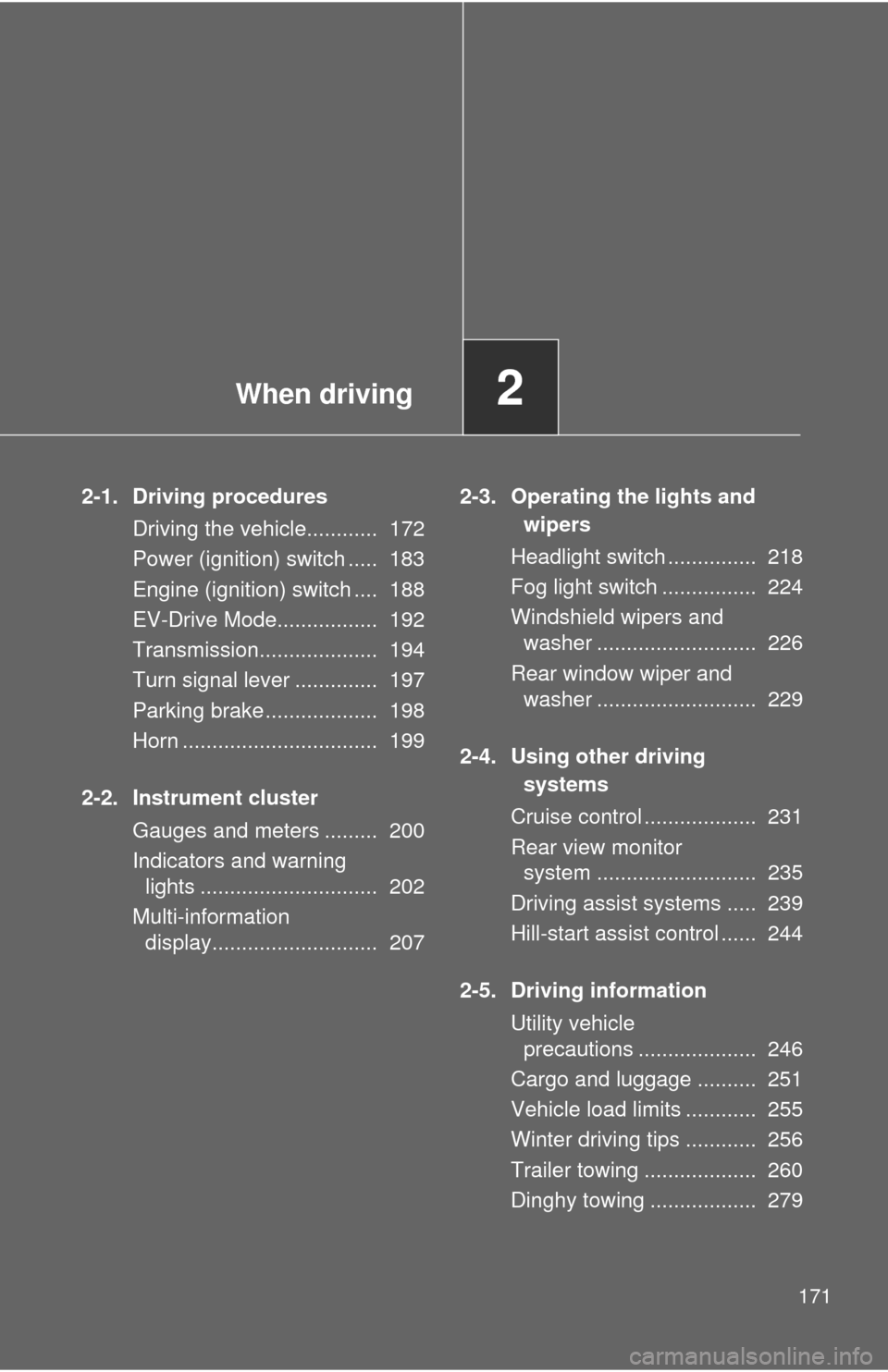
When driving2
171
2-1. Driving proceduresDriving the vehicle............ 172
Power (ignition) switch ..... 183
Engine (ignition) switch .... 188
EV-Drive Mode................. 192
Transmission.................... 194
Turn signal lever .............. 197
Parking brake ................... 198
Horn ................................. 199
2-2. Instrument cluster Gauges and meters ......... 200
Indicators and warning lights .............................. 202
Multi-information display............................ 207 2-3. Operating the lights and
wipers
Headlight switch ............... 218
Fog light switch ................ 224
Windshield wipers and washer ........................... 226
Rear window wiper and washer ........................... 229
2-4. Using other driving systems
Cruise control ................... 231
Rear view monitor system ........................... 235
Driving assist systems ..... 239
Hill-start assist control ...... 244
2-5. Driving information Utility vehicle precautions .................... 246
Cargo and luggage .......... 251
Vehicle load limits ............ 255
Winter driving tips ............ 256
Trailer towing ................... 260
Dinghy towing .................. 279
Page 173 of 676

173
2-1. Driving procedures
2
When driving
Starting on a steep uphill
Firmly set the parking brake and shift the shift lever to D.
Gently depress the accelerator pedal.
Release the parking brake.
■Driving in the rain
●Drive carefully when it is raining, because visibility will be reduced, the
windows may become fogged-up, and the road will be slippery.
● Drive carefully when it starts to rain, because the road surface will be
especially slippery.
● Refrain from high speeds when driving on an expressway in the rain,
because there may be a layer of water between the tires and the road
surface, preventing the steering and brakes from operating properly.
■ Breaking in your new Toyota
To extend the life of the vehicle, observing the following precautions is rec-
ommended:
●For the first 186 miles (300 km):
Avoid sudden stops.
● For the first 500 miles (800 km):
Do not tow a trailer.
● For the first 621 miles (1000 km):
• Do not drive at extremely high speeds.
• Avoid sudden acceleration.
• Do not drive continuously in the low gears.
• Do not drive at a constant speed for extended periods.
■ Drum-in-disc type parking brake system
Your vehicle has a drum-in-disc type parking brake system.
This type of brake system needs bedding-down of the brake shoes periodi-
cally or whenever the parking brake shoes and/or drums are replaced.
Have your Toyota dealer perform the bedding-down.
STEP1
STEP2
STEP3
Page 234 of 676
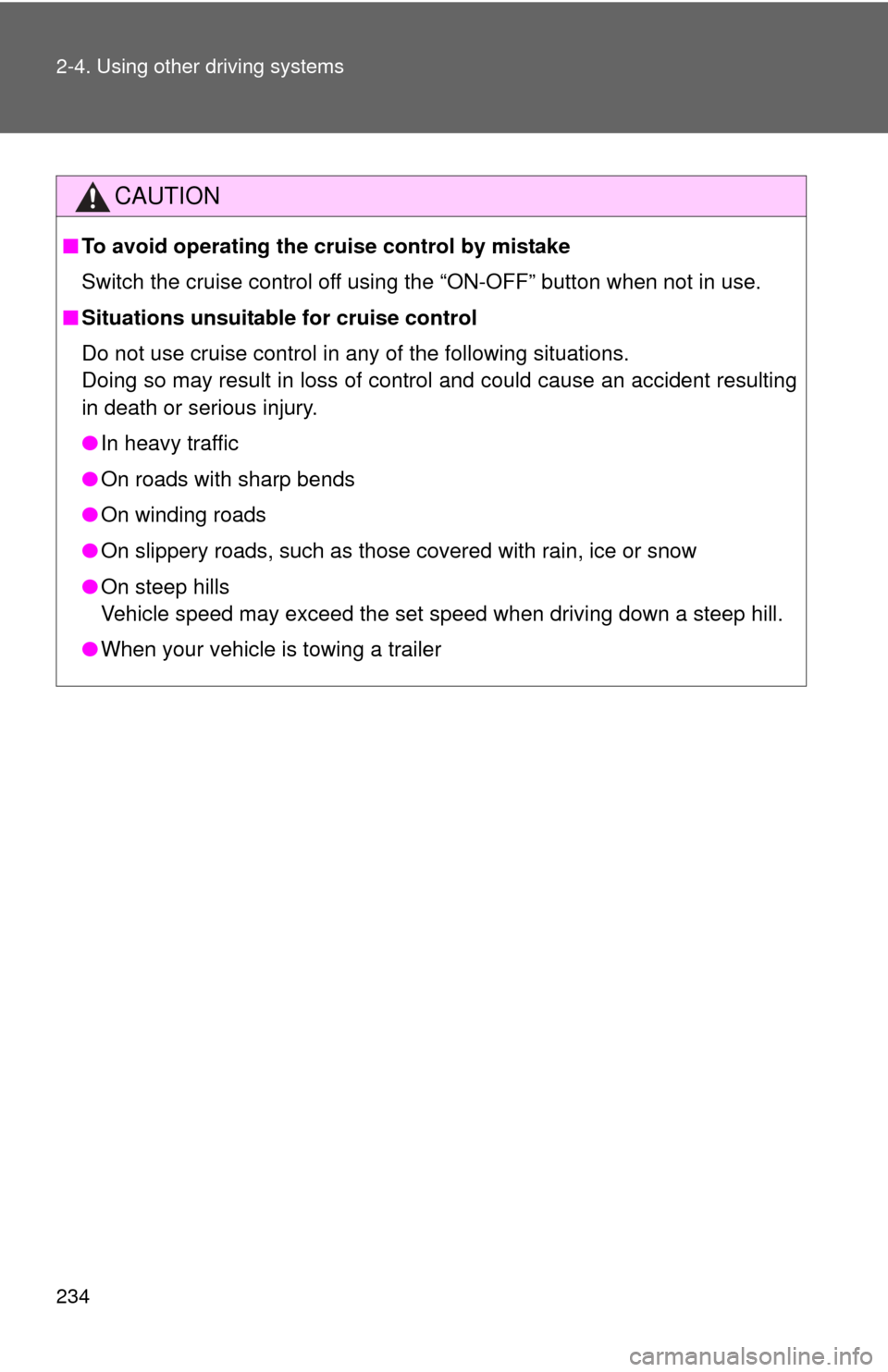
234 2-4. Using other driving systems
CAUTION
■To avoid operating the cruise control by mistake
Switch the cruise control off using the “ON-OFF” button when not in use.
■ Situations unsuitable for cruise control
Do not use cruise control in any of the following situations.
Doing so may result in loss of control and could cause an accident resulting
in death or serious injury.
●In heavy traffic
● On roads with sharp bends
● On winding roads
● On slippery roads, such as those covered with rain, ice or snow
● On steep hills
Vehicle speed may exceed the set speed when driving down a steep hill.
● When your vehicle is towing a trailer
Page 252 of 676
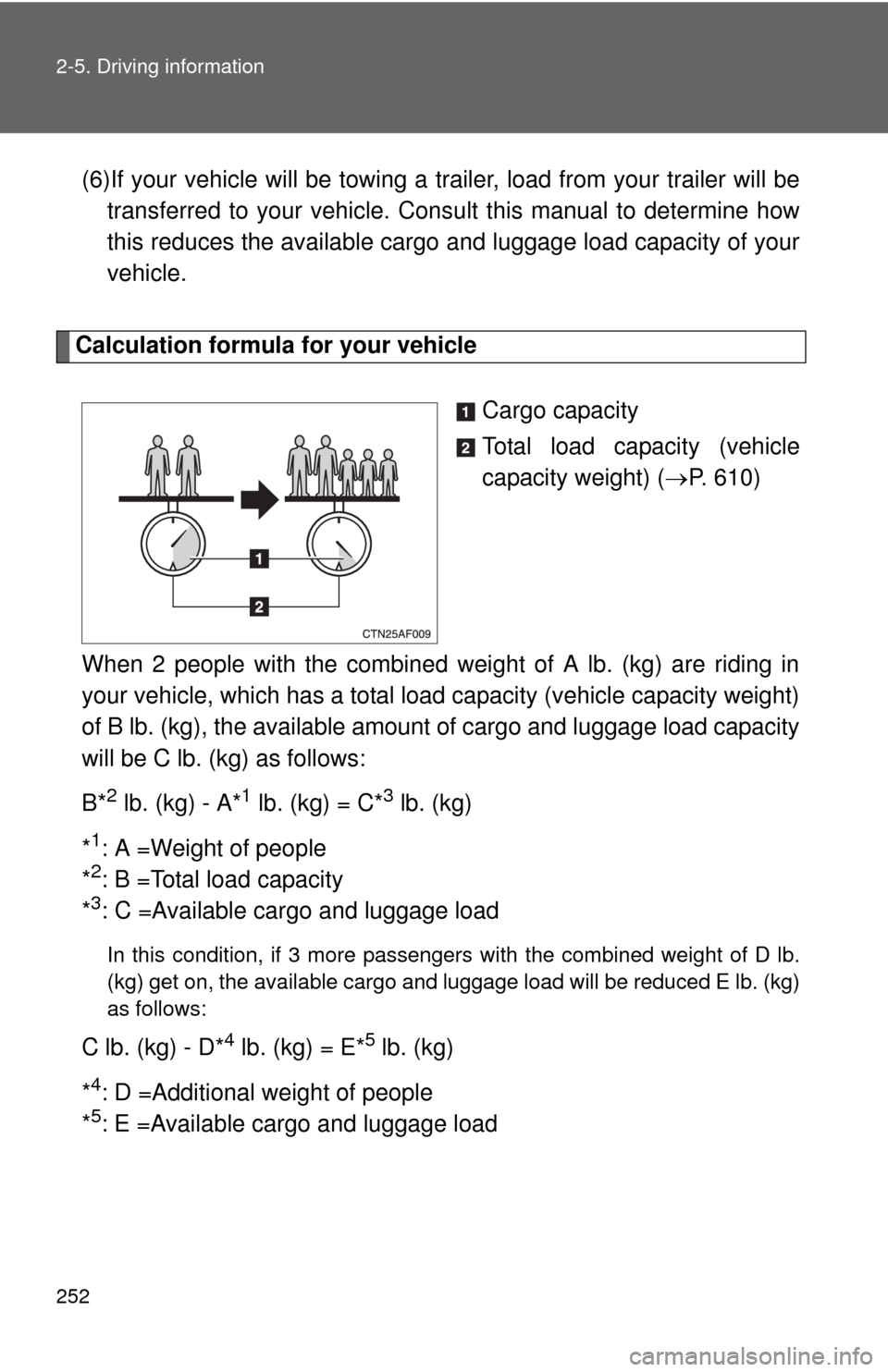
252 2-5. Driving information
(6)If your vehicle will be towing a trailer, load from your trailer will be
transferred to your vehicle. Cons ult this manual to determine how
this reduces the available cargo and luggage load capacity of your
vehicle.
Calculation formula for your vehicle
Cargo capacity
Total load capacity (vehicle
capacity weight) (P. 610)
When 2 people with the combined weight of A lb. (kg) are riding in
your vehicle, which has a total load capacity (vehicle capacity weight)
of B lb. (kg), the available amount of cargo and luggage load capacity
will be C lb. (kg) as follows:
B*
2 lb. (kg) - A*1 lb. (kg) = C*3 lb. (kg)
*
1: A =Weight of people
*2: B =Total load capacity
*3: C =Available cargo and luggage load
In this condition, if 3 more passengers with the combined weight of D lb.
(kg) get on, the available cargo and luggage load will be reduced E lb\
. (kg)
as follows:
C lb. (kg) - D*4 lb. (kg) = E*5 lb. (kg)
*
4: D =Additional weight of people
*5: E =Available cargo and luggage load
Page 255 of 676
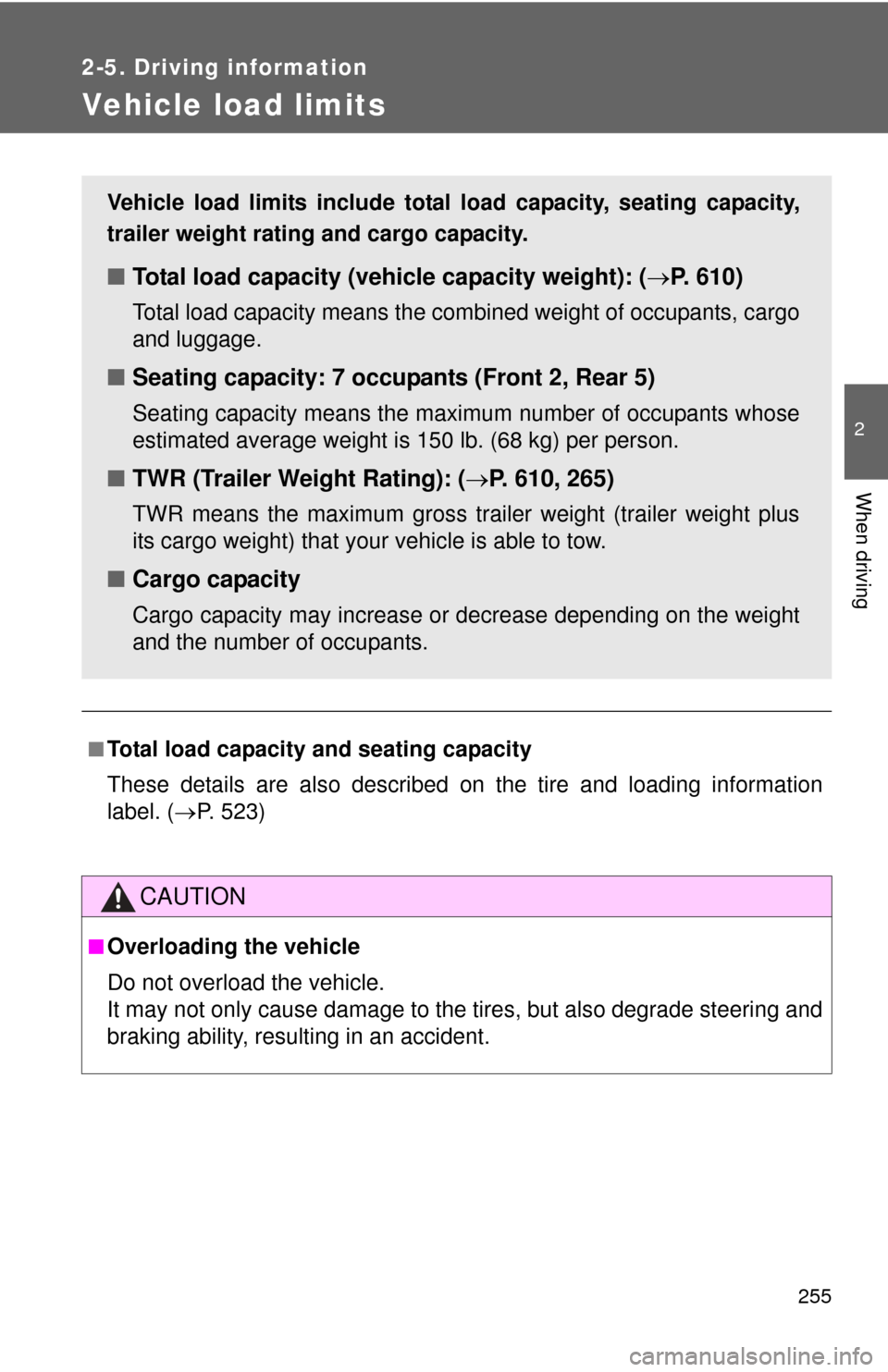
255
2-5. Driving information
2
When driving
Vehicle load limits
■Total load capacity and seating capacity
These details are also described on the tire and loading information
label. (P. 523)
CAUTION
■Overloading the vehicle
Do not overload the vehicle.
It may not only cause damage to the ti res, but also degrade steering and
braking ability, resulting in an accident.
Vehicle load limits include total load capacity, seating capacity,
trailer weight rating and cargo capacity.
■ Total load capacity (vehicle capacity weight): ( P. 610)
Total load capacity means the combined weight of occupants, cargo
and luggage.
■ Seating capacity: 7 occupants (Front 2, Rear 5)
Seating capacity means the maxi mum number of occupants whose
estimated average weight is 150 lb. (68 kg) per person.
■ TWR (Trailer Weight Rating): ( P. 610, 265)
TWR means the maximum gross tra iler weight (trailer weight plus
its cargo weight) that your vehicle is able to tow.
■ Cargo capacity
Cargo capacity may increase or decrease depending on the weight
and the number of occupants.
Page 260 of 676
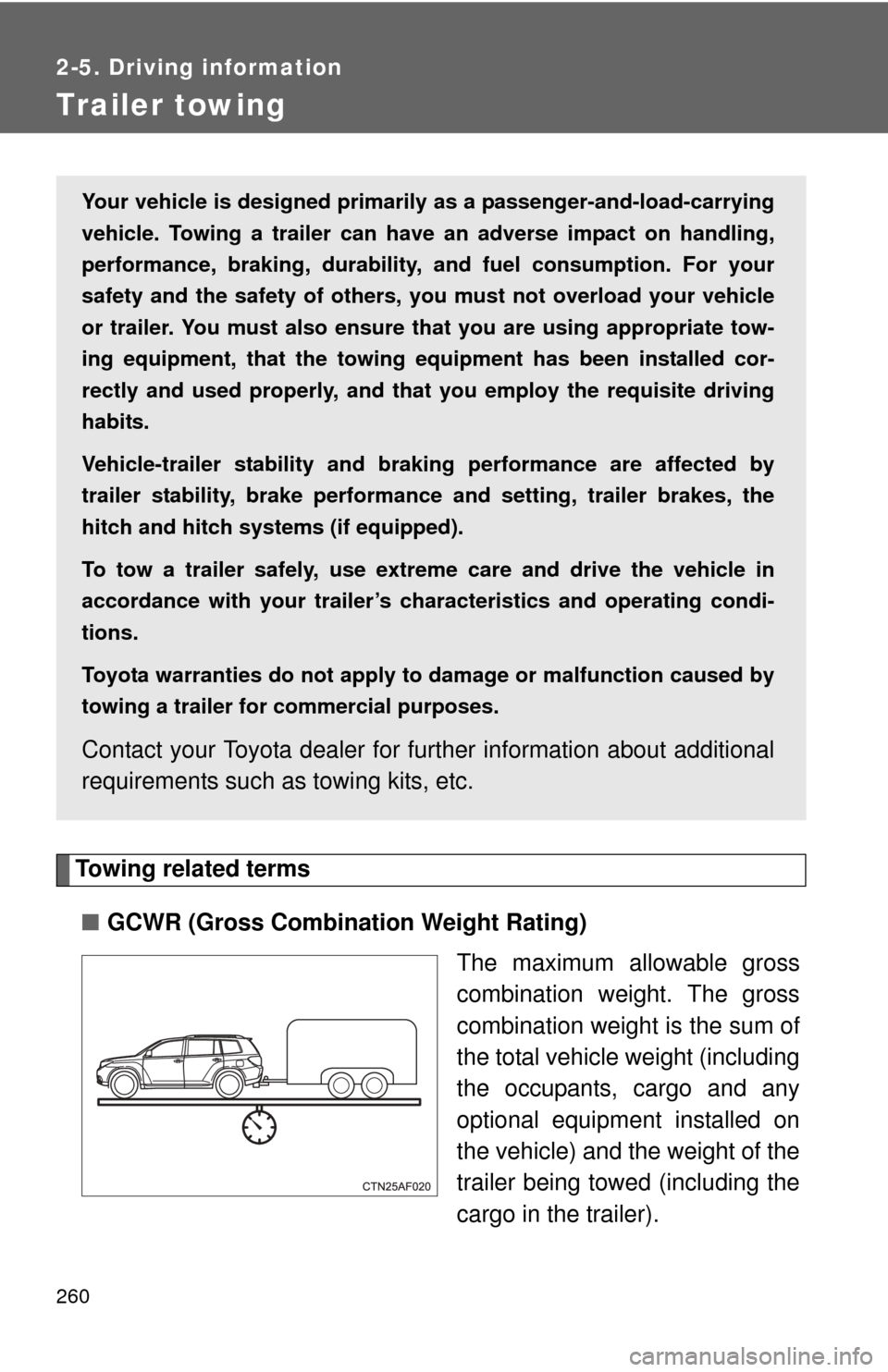
260
2-5. Driving information
Trailer towing
Towing related terms■ GCWR (Gross Combination Weight Rating)
The maximum allowable gross
combination weight. The gross
combination weight is the sum of
the total vehicle weight (including
the occupants, cargo and any
optional equipment installed on
the vehicle) and the weight of the
trailer being towed (including the
cargo in the trailer).
Your vehicle is designed primarily as a passenger-and-load-carrying
vehicle. Towing a trailer can have an adverse impact on handling,
performance, braking, durability, and fuel consumption. For your
safety and the safety of others, yo u must not overload your vehicle
or trailer. You must also ensure that you are using appropriate tow-
ing equipment, that the towing eq uipment has been installed cor-
rectly and used properly, and that you employ the requisite driving
habits.
Vehicle-trailer stability and br aking performance are affected by
trailer stability, brake performan ce and setting, trailer brakes, the
hitch and hitch systems (if equipped).
To tow a trailer safely, use extreme care and drive the vehicle in
accordance with your trailer’s characteristics and operating condi-
tions.
Toyota warranties do not apply to damage or malfunction caused by
towing a trailer for commercial purposes.
Contact your Toyota dealer for fu rther information about additional
requirements such as towing kits, etc.
Page 261 of 676
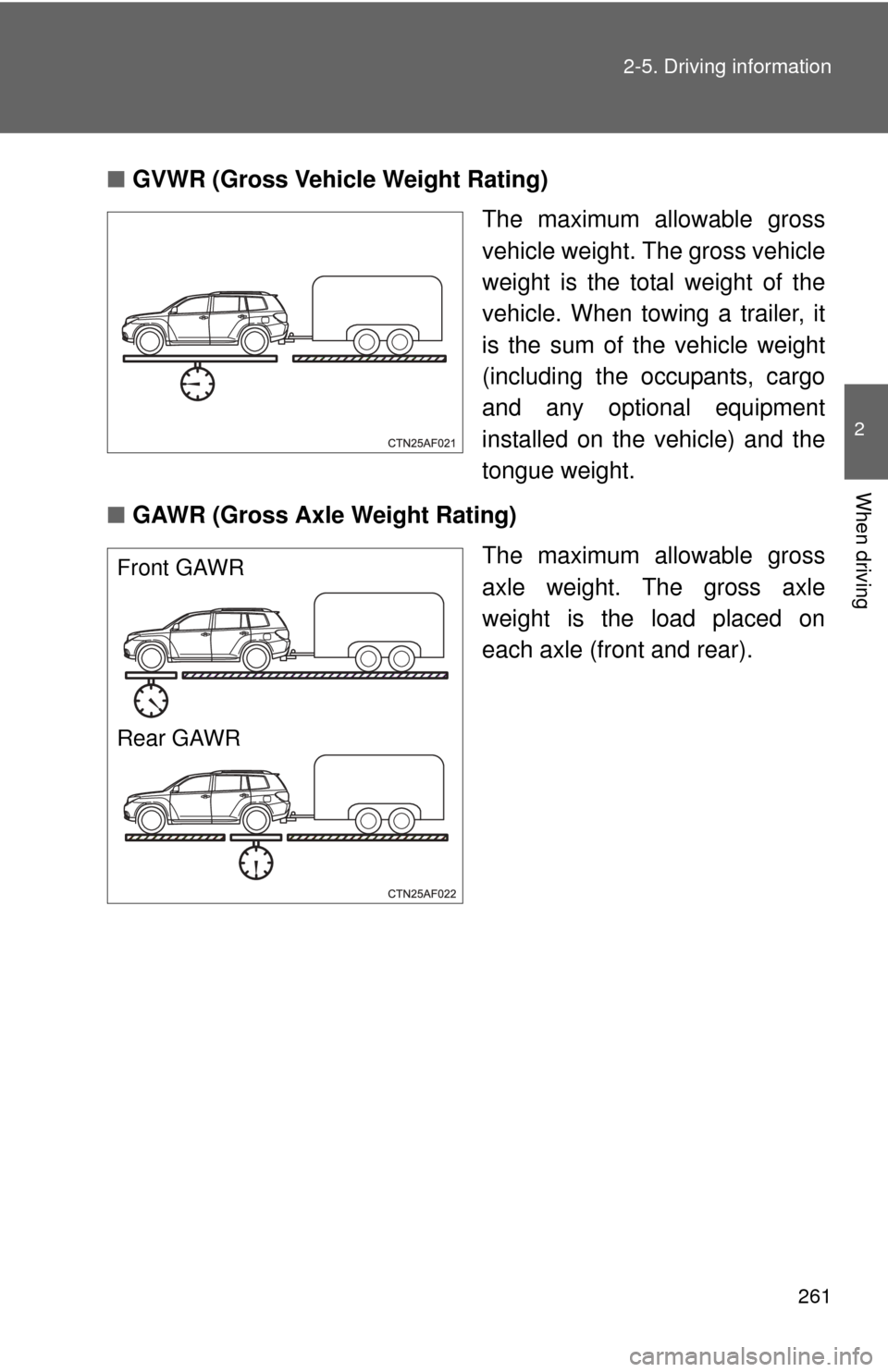
261
2-5. Driving information
2
When driving
■
GVWR (Gross Vehicle Weight Rating)
The maximum allowable gross
vehicle weight. The gross vehicle
weight is the total weight of the
vehicle. When towing a trailer, it
is the sum of the vehicle weight
(including the occupants, cargo
and any optional equipment
installed on the vehicle) and the
tongue weight.
■ GAWR (Gross Axle Weight Rating)
The maximum allowable gross
axle weight. The gross axle
weight is the load placed on
each axle (front and rear).
Front GAWR
Rear GAWR
Page 262 of 676
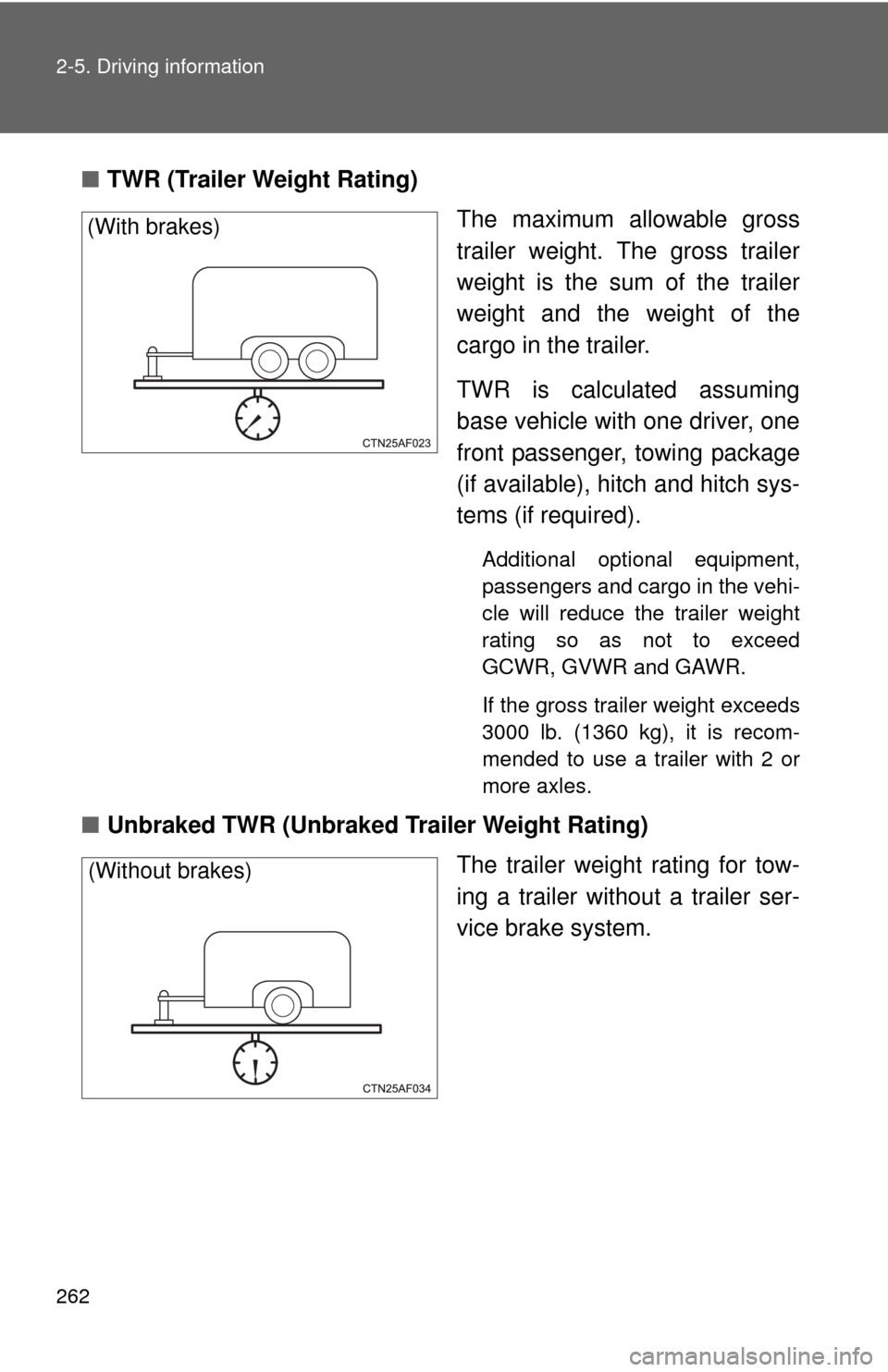
262 2-5. Driving information
■TWR (Trailer Weight Rating)
The maximum allowable gross
trailer weight. The gross trailer
weight is the sum of the trailer
weight and the weight of the
cargo in the trailer.
TWR is calculated assuming
base vehicle with one driver, one
front passenger, towing package
(if available), hitch and hitch sys-
tems (if required).
Additional optional equipment,
passengers and cargo in the vehi-
cle will reduce the trailer weight
rating so as not to exceed
GCWR, GVWR and GAWR.
If the gross trailer weight exceeds
3000 lb. (1360 kg), it is recom-
mended to use a trailer with 2 or
more axles.
■Unbraked TWR (Unbraked Trailer Weight Rating)
The trailer weight rating for tow-
ing a trailer without a trailer ser-
vice brake system.
(With brakes)
(Without brakes)
Page 263 of 676
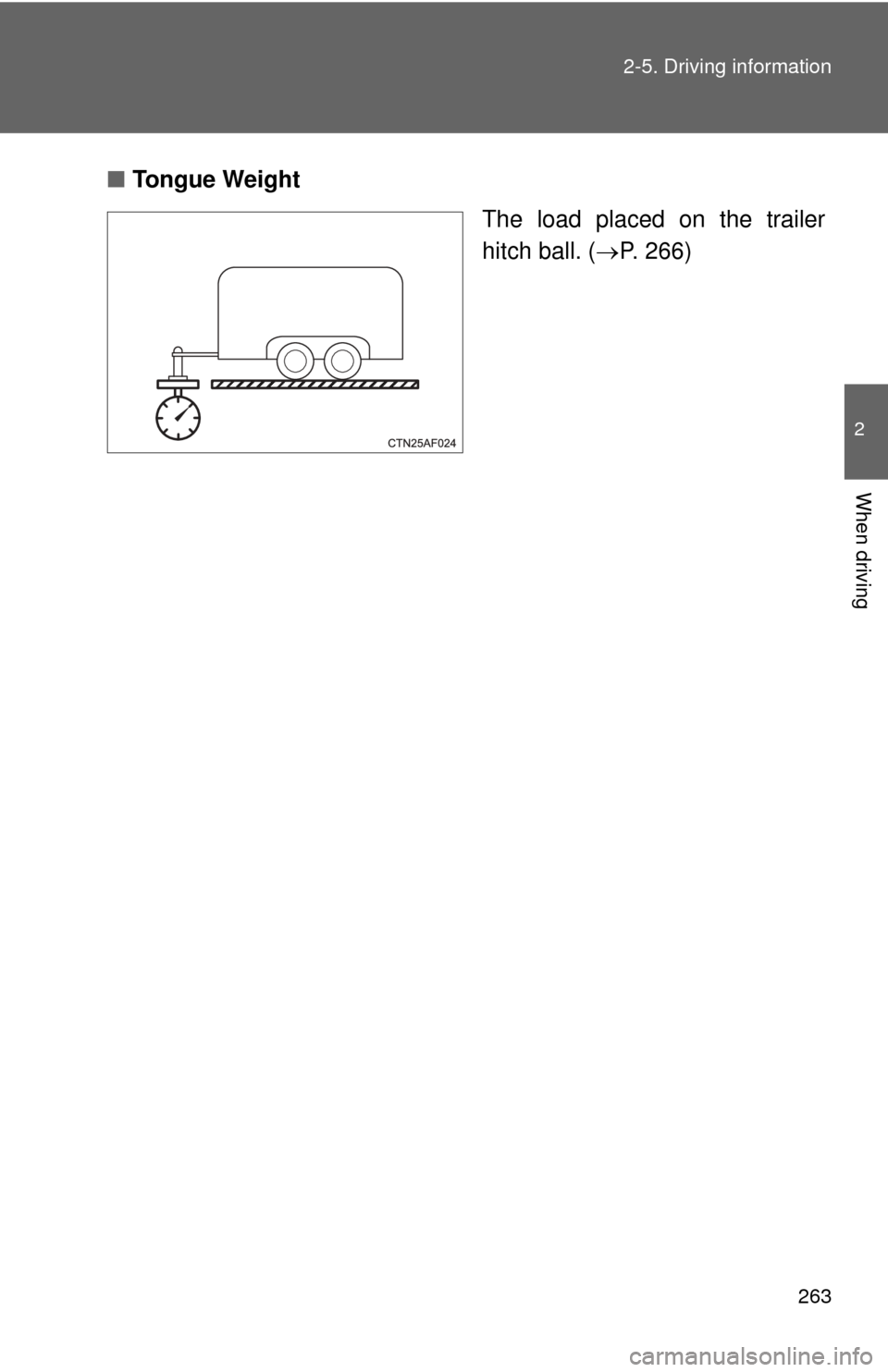
263
2-5. Driving information
2
When driving
■
Tongue Weight
The load placed on the trailer
hitch ball. (P. 266)